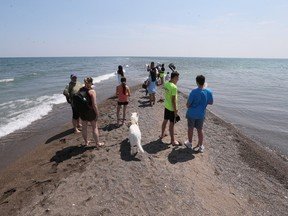
Article content
In Canada’s southern-most region, the wilderness stays green for a lot longer than most of the Great White North — even if that wilderness is scarcer than just about anywhere else in the country.
Sign In or Create an Account
or View more offersArticle content
The warm weather is a big reason outdoor adventurers flock to Windsor and Essex County for many months of the year, says Gordon Orr, CEO of both Tourism Windsor Essex Pelee Island and Invest WindsorEssex.
Article contentArticle content Story continues below This advertisement has not loaded yet, but your article continues below. Article content
Much of the region is either urban or actively farmed, and it has one of the lowest tree covers in Ontario. But that makes the green spaces it does have more precious to residents and visitors alike.
Article content
“It’s a way to appreciate and celebrate the environment and your surroundings, to escape into and put on a nature lens,” Orr told the Star
Article content
“Because we’re the southernmost region in Canada, we’re afforded a longer season for tourism, and for enjoying these nature walks. It starts with birding in April and particularly in May, and then goes right through the fall.
Article content
“You can enjoy the peace and tranquility, and the sights and the sounds of the world around us.”
Article content
With a bit of sunblock and bug spray, visitors can spend days exploring beaches, woods, marshes and meadows with lower latitudes than several U.S. states.
Article content
Here are some must-visit natural areas in Windsor and Essex County:
Article content Story continues below This advertisement has not loaded yet, but your article continues below. Article content
Peche Island
Article contentRead More
-
 With Parliament prorogued, Windsor’s national urban park bill is dead — so what happens now?
With Parliament prorogued, Windsor’s national urban park bill is dead — so what happens now? -
 Birds, birds, birds — and bird lovers — flocking to Windsor-Essex
Birds, birds, birds — and bird lovers — flocking to Windsor-Essex - Advertisement embed-more-topicStory continues belowThis advertisement has not loaded yet, but your article continues below.
Article content
This uninhabited 86-acre island sits where Lake St. Clair funnels into the Detroit River. It’s home to provincially significant wetlands, which attract numerous species of waterfowl.
Article content
The ruins of whisky baron Hiram Walker’s mansion — destroyed in a 1929 fire — are still visible on the island.
Article content

Article content
In warmer months, the City of Windsor, which acquired the island in 1999, offers boat rides to and from Peche Island out of Lakeview Park Marina, about 330 metres away on the mainland. It’s also possible to kayak and canoe over.
Article content
Ojibway Prairie Complex
Article content
This collection of six natural areas located in west Windsor includes rare wetlands, forest, savanna and prairie habitats for more than 4,000 species, including 160 rare plants, insects, reptiles, birds, and mammals among them. The sites — Ojibway Park, Tallgrass Prairie Heritage Park, Black Oak Heritage Park, Spring Garden Natural Area, Oakwood Natural Area, and Ojibway Prairie Provincial Nature Reserve — have trails and span more than 350 hectares. Most of them are designated areas of natural and scientific interest, which is land scientifically identified as important to natural heritage, protection, scientific study, or education.